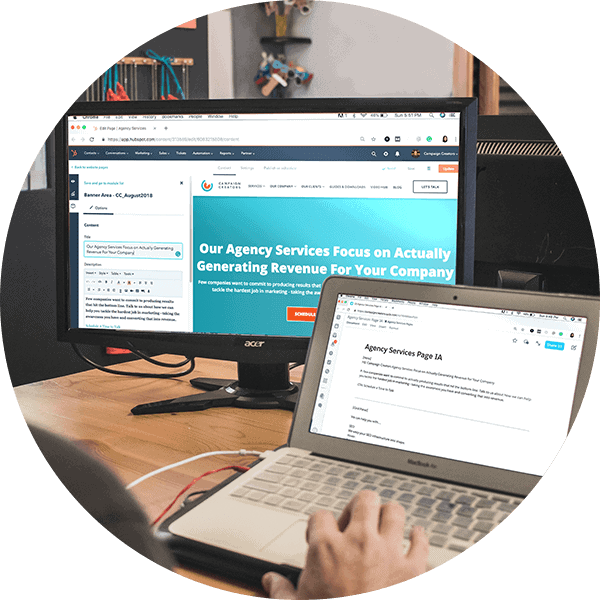
14 Digital Marketing Metrics You Should Be Keeping an Eye on
March 30, 2017
5 Tips For Blogging in Professional Industries
June 1, 2017
The key to building a small business up from scratch isn’t just having the right product or service, or even being in the right location, but to make sure that you are the first company your potential clients think of when they are searching for the solution to their unique problem.
One of the best ways to stay at the top of a client’s mind? Fresh, updated content appearing regularly on your site and shared throughout social media! Starting a company blog is a great way to make new information readily and easily available to your clients without bogging your actual website down with a thousand individual pages that become difficult, confusing, and frustrating for clients to attempt to navigate.
If you’re looking to start up a blog for your business, we have three essential steps help you enhance your online presence and bring in the potential leads that you’ve been searching for.
1. Ask Yourself — “Who Am I Writing To?”
I know, I know—you’re probably already tired of all my blog posts suggesting you create and utilize buyer personas when it comes to just about everything you do… but I really can’t stop!
Buyer personas are the most important part of your content marketing strategy, especially if you’re a small business owner focused on growing your business by using Inbound Marketing techniques.
Your blog won’t help you unless it’s something your clients want to read.
Writing about your favorite gardening tips and tricks won’t help you sell ATVs, but a blog post about what to do when your ATV’s battery is dead may be the perfect introduction to your site—leading customers to click over to your new inventory to see what you’ve got in stock.
Wondering just what a buyer persona is? It’s a really common question. A buyer persona is a semi-fictional representation of your ideal customer. When building your buyer persona, you’ll want to take a look at any customer data you have, such as:
- Average age
- Whether your average customer is male or female
- If they have kids and if so, how old their children are
- Is your average customer a homeowner or do they rent?
- What are their interests/likes and dislikes?
- Are they the type to prefer city living or a more rural lifestyle?
This may seem like a lot of detail, but it will help you to develop your company ‘voice’ and marketing strategy. It may be as simple as keeping track of these details for a few weeks, or you may want to contact a company to do some research to help you build your ideal buyer persona.
Once you have those buyer personas in hand, you’ll know exactly who you’re trying to connect with on your company blog.
2. Set a Schedule
We’ve all seen those sad business blogs that only have three posts in three years.
A business blog just plain doesn’t work if it’s not regularly updated.
Even business owners or employees with the absolute best of intentions can find themselves forgetting to update or feeling like they’re just too busy to give the blog the attention it needs to maintain fresh content.
Do whatever it takes to remind and motivate yourself to write and publish a fresh, new blog article at least once every two weeks—make a note on your whiteboard, add it to your to-do list, set an event reminder in your Google Calendar… anything it takes to make sure you remember to carve out time to write great blog articles!
We believe a company blog should be updated about once per month at the very minimum. To get the best results, we suggest blogging once a week or every two weeks so that content continues to pop up where potential leads and current customers can easily find it.
If you can’t maintain a schedule of at least once per month, a company blog may not be the right choice for you—or you may want to ask an employee or Inbound Marketing team (like us!) to give you some help.
3. Remind Yourself — It’s Just Business
We understand that the line between what’s personal and what’s business can get very blurred, especially when you’re a small business owner pouring your heart and soul into a fledgling company. After all, my last two posts have been all about storytelling and how small business owners need to tell their story to reach customers, right?
There’s a difference between telling the story of what your business does, how it provides the service or product you’ve chosen to focus on, and why you do it and straying into the kinds of topics that you’ll want to avoid to maintain a successful blog.
We really cannot emphasize enough that you should never let personal topics take over a business blog.
Politics, certain personal events involving friends or family members, conflicts with customers, or issues that are taking place in the workplace are all great examples of topics that should never appear on your company’s blog.
There are some exceptions to the rule, of course. Customers often love to hear positive updates like the promotion of an employee or when someone new is hired. In businesses that operate as the “neighborhood store,” you may find you have a personal connection with your customers that justifies making the occasional more personal post (just make sure it still provides some level of value).
One great example of this sort of post would be a health and wellness-focused cafe celebrating a regular morning customer of theirs who recently ran his first 5k at age 60. It’s not just an achievement worth celebrating for the customer, it’s relevant to the cafe’s story and provides a sense of authenticity and personal connection to the community.
If you do choose to take this route for a blog post or two, just make sure the person or people you’re writing about have given their permission to have their name, photo, and/or story used on your blog and potentially shared with hundreds of people.
Before any ‘personal’ blog you post to your company page, though, ask yourself one question: Does this add value to my customers’ experience on my site?
If the answer is anything other than a resounding “YES”, don’t publish the post.
Too Busy for a Business Blog? Inbound Marketing May Be the Answer.
Whether you’re just too busy with your growing business to update your company blog regularly—or you’d just really like to be that busy—Inbound Marketing may be just the tactic you’ve been searching for to bring potential clients or customers right to your doorstep.
We’re a full-service Inbound Marketing agency that can provide everything from mobile-responsive web design to content marketing—like blogs, ebooks, infographics, and more—to regularly updated social media accounts that help find your customers where they are so they can find you.
To learn more about what Waypost Marketing has to offer and how we can help you grow your business, give us a call at (864) 288-6162 or contact us online to get started.









